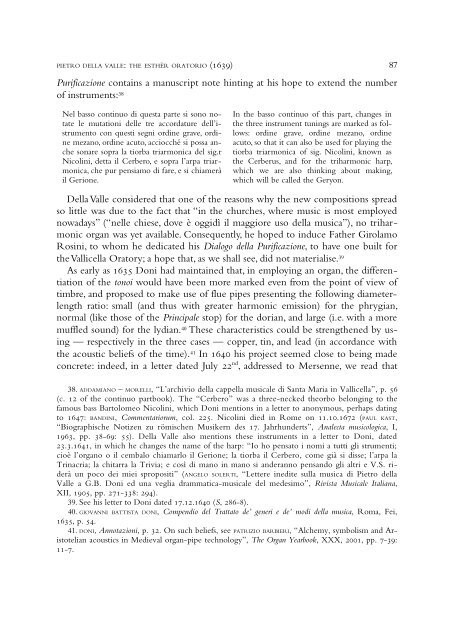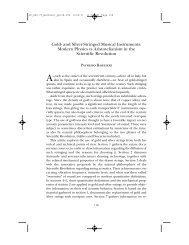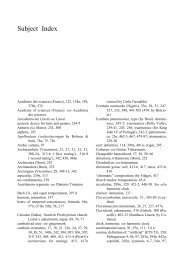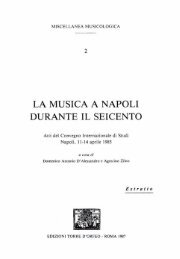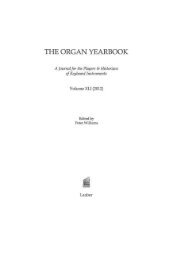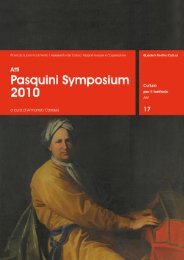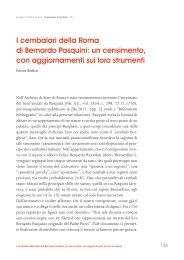You also want an ePaper? Increase the reach of your titles
YUMPU automatically turns print PDFs into web optimized ePapers that Google loves.
PIETRO DELLA VALLE: THE ESTHÈR ORATORIO (1639) 87<br />
Purificazione contains a manuscript note hinting at his hope to extend the number<br />
of instruments: 38<br />
Nel basso continuo di questa parte si sono notate<br />
le mutationi delle tre accordature dell’istrumento<br />
con questi segni ordine grave, ordine<br />
mezano, ordine acuto, acciocché si possa anche<br />
sonare sopra la tiorba triarmonica del sig.r<br />
Nicolini, detta il Cerbero, e sopra l’arpa triarmonica,<br />
che pur pensiamo di fare, e si chiamerà<br />
il Gerione.<br />
In the basso continuo of this part, changes in<br />
the three instrument tunings are marked as follows:<br />
ordine grave, ordine mezano, ordine<br />
acuto, so that it can also be used for playing the<br />
tiorba triarmonica of sig. Nicolini, known as<br />
the Cerberus, and for the triharmonic harp,<br />
which we are also thinking about making,<br />
which will be called the Geryon.<br />
Della Valle considered that one of the reasons why the new compositions spread<br />
so little was due to the fact that “in the churches, where music is most employed<br />
nowadays” (“nelle chiese, dove è oggidì il maggiore uso della musica”), no triharmonic<br />
organ was yet available. Consequently, he hoped to induce Father Girolamo<br />
Rosini, to whom he dedicated his Dialogo della Purificazione, to have one built for<br />
the Vallicella Oratory; a hope that, as we shall see, did not materialise. 39<br />
As early as 1635 Doni had maintained that, in employing an organ, the differentiation<br />
of the tonoi would have been more marked even from the point of view of<br />
timbre, and proposed to make use of flue pipes presenting the following diameterlength<br />
ratio: small (and thus with greater harmonic emission) for the phrygian,<br />
normal (like those of the Principale stop) for the dorian, and large (i.e. with a more<br />
muffled sound) for the lydian. 40 These characteristics could be strengthened by using<br />
— respectively in the three cases — copper, tin, and lead (in accordance with<br />
the acoustic beliefs of the time). 41 In 1640 his project seemed close to being made<br />
concrete: indeed, in a letter dated July 22 nd , addressed to Mersenne, we read that<br />
38. ADDAMIANO – MORELLI, “L’archivio della cappella musicale di Santa Maria in Vallicella”, p. 56<br />
(c. 12 of the continuo partbook). The “Cerbero” was a three-necked theorbo belonging to the<br />
famous bass Bartolomeo Nicolini, which Doni mentions in a letter to anonymous, perhaps dating<br />
to 1647: BANDINI, Commentariorum, col. 225. Nicolini died in Rome on 11.10.1672 (PAUL KAST,<br />
“Biographische Notizen zu römischen Musikern des 17. Jahrhunderts”, Analecta musicologica, I,<br />
1963, pp. 38-69: 55). Della Valle also mentions these instruments in a letter to Doni, dated<br />
23.3.1641, in which he changes the name of the harp: “Io ho pensato i nomi a tutti gli strumenti;<br />
cioè l’organo o il cembalo chiamarlo il Gerione; la tiorba il Cerbero, come già si disse; l’arpa la<br />
Trinacria; la chitarra la Trivia; e così di mano in mano si anderanno pensando gli altri e V.S. riderà<br />
un poco dei miei spropositi” (ANGELO SOLERTI, “Lettere inedite sulla musica di Pietro della<br />
Valle a G.B. Doni ed una veglia drammatica-musicale del medesimo”, Rivista Musicale Italiana,<br />
XII, 1905, pp. 271-338: 294).<br />
39. See his letter to Doni dated 17.12.1640 (S, 286-8).<br />
40. GIOVANNI BATTISTA DONI, Compendio del Trattato de’ generi e de’ modi della musica, Roma, Fei,<br />
1635, p. 54.<br />
41. DONI, Annotazioni, p. 32. On such beliefs, see PATRIZIO BARBIERI, “Alchemy, symbolism and Aristotelian<br />
acoustics in Medieval organ-pipe technology”, The Organ Yearbook, XXX, 2001, pp. 7-39:<br />
11-7.


